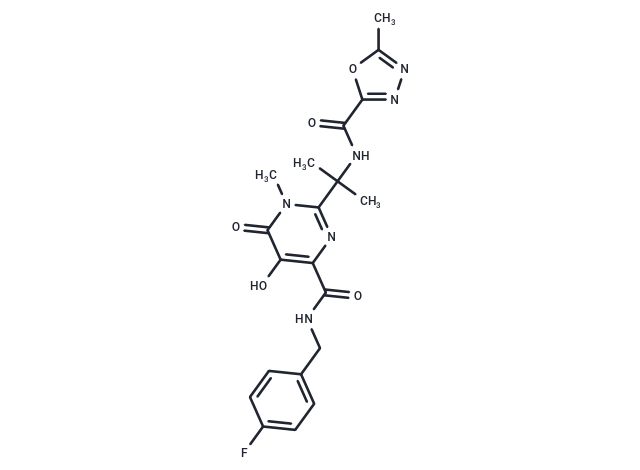Shopping Cart
- Remove All
 Your shopping cart is currently empty
Your shopping cart is currently empty

Raltegravir (MK-0518) is a pyrrolidinone derivative and HIV INTEGRASE INHIBITOR that is used in combination with other ANTI-HIV AGENTS for the treatment of HIV INFECTION.

| Pack Size | Price | Availability | Quantity |
|---|---|---|---|
| 2 mg | $38 | In Stock | |
| 5 mg | $58 | In Stock | |
| 10 mg | $106 | In Stock | |
| 25 mg | $192 | In Stock | |
| 50 mg | $318 | In Stock | |
| 100 mg | $473 | In Stock | |
| 1 mL x 10 mM (in DMSO) | $58 | In Stock |
| Description | Raltegravir (MK-0518) is a pyrrolidinone derivative and HIV INTEGRASE INHIBITOR that is used in combination with other ANTI-HIV AGENTS for the treatment of HIV INFECTION. |
| Targets&IC50 | Integrase (S217Q PFV):40 nM, Integrase (WT PFV):90 nM |
| In vitro | Raltegravir induces immunological improvement in non-human primate viruses, accompanied by progressive SIVmac251 infection. |
| In vivo | Raltegravir effectively inhibits HIV-1 in vitro with a 95% inhibitory concentration of 31±20 nM in human T lymphocyte cultures. It maintains similar sensitivity to the S217Q PFV IN mutation as compared to the wild-type enzyme. In the human lymphoid CD4+ T cell lines MT-4 and CEMx174, raltegravir potently suppresses SIVmac251 replication, demonstrating an EC90 in the low nanomolar range. It weakly inhibits cytochrome P450 liver enzymes and does not induce the expression of CYP3A4 RNA or the activity of the CYP3A4-dependent 6-β-hydroxylase enzyme involved in testosterone metabolism. The presence of magnesium and calcium reduces raltegravir's cell permeability. Raltegravir, along with related HIV-1 integrase strand transfer inhibitors, effectively blocks viral replication. |
| Kinase Assay | PFV integration assay: For quantitative strand transfer assays, donor DNA substrate is formed by annealing HPLC grade oligonucleotides 5′-GACTCACTATAGGGCACGCGTCAAAATTCCATGACA and 5′-ATTGTCATG GAATTTTGACGCGTGCCCTATAGTGAGTC. Reactions (40 μL) contains 0.75 μM PFV IN, 0.75 μM donor DNA, 4 nM (300 ng) supercoiled pGEM9-Zf(?) target DNA, 125 mM NaCl, 5 mM MgSO4, 4 μM ZnCl2, 10 mM DTT, 0.8% (vol/vol) DMSO, and 25 mM BisTris propane–HCl, pH 7.45. Raltegravir is added at indicated concentrations. Reactions are initiated by addition of 2 μL PFV IN diluted in 150 mM NaCl, 2 mM DTT, and 10 mM Tris-HCl, pH 7.4, and stopped after 1 hour at 37 °C by addition of 25 mM EDTA and 0.5% (wt/vol) SDS. Reaction products, deproteinized by digestion with 20 μg proteinase K for 30 minutes at 37 °C followed by ethanol precipitation, are separated in 1.5% agarose gels and visualized by staining with ethidium bromide. Integration products are quantified by quantitative real-time PCR, using Platinum SYBR Green qPCR SuperMix and three primers: 5′-CTACTTACTCTAGCTTCCCGGCAAC, 5′-TTCGCCAGTTAATAGTTTGCGCAAC, and 5′-GACTCACTATAGGGCACGCGT. PCR reactions (20 μL) contained 0.5 μM of each primer and 1 μL diluted integration reaction product. Following a 5-min denaturation step at 95 °C, 35 cycles are carried out in a CFX96 PCR instrument, using 10 seconds denaturation at 95 °C, 30 seconds annealing at 56 °C and 1 minutes extension at 68 °C. Standard curves are generated using serial dilutions of WT PFV IN reaction in the absence of INSTI. |
| Cell Research | Human MT-4 cells are infected for 2 hours with the SIVmac251, HIV-1 (IIIB) and HIV-2 (CDC 77618) stocks at a multiplicity of infection of, approximately, 0.1. Cells are then washed three times in phosphate buffered saline, and suspended at 5 × 105/mL in fresh culture medium (to primary cells 50 units/mL of IL-2 are added) in 96-well plates, in the presence or absence of a range of triplicate raltegravir concentrations (0.0001 μM -1 μM). Untreated infected and mock-infected controls are prepared too, in order to allow comparison of the data derived from the different treatments. Viral cytopathogeniciy in MT-4 cells is quantitated by the methyl tetrazolium (MTT) method (MT-4/MTT assay) when extensive cell death in control virus-infected cell cultures is detectable microscopically as lack of capacity to re-cluster. The capability of MT-4 cells to form clusters after infection. Briefly, clusters are disrupted by pipetting; and, after 2 hours of incubation at 37 °C, the formation of new clusters is assessed by light microscopy (100 × magnification). Cell culture supernatants are collected for HIV-1 p24 and HIV-2/SIVmac251 p27 core antigen measurement by ELISA. In CEMx174-infected cell cultures, which show a propensity to form syncytia induced by the virus envelope glycoproteins, syncytia are counted, in blinded fashion, by light microscopy for each well at 5 days following infection. (Only for Reference) |
| Alias | MK-0518 |
| Molecular Weight | 444.42 |
| Formula | C20H21FN6O5 |
| Cas No. | 518048-05-0 |
| Smiles | Cc1nnc(o1)C(=O)NC(C)(C)c1nc(C(=O)NCc2ccc(F)cc2)c(O)c(=O)n1C |
| Relative Density. | 1.46 g/cm3 |
| Storage | Powder: -20°C for 3 years | In solvent: -80°C for 1 year | Shipping with blue ice/Shipping at ambient temperature. | |||||||||||||||||||||||||||||||||||
| Solubility Information | H2O: < 1 mg/mL (insoluble or slightly soluble) DMSO: 82 mg/mL (184.51 mM), Sonication is recommended. Ethanol: < 1 mg/mL (insoluble or slightly soluble) | |||||||||||||||||||||||||||||||||||
Solution Preparation Table | ||||||||||||||||||||||||||||||||||||
DMSO
| ||||||||||||||||||||||||||||||||||||

Copyright © 2015-2025 TargetMol Chemicals Inc. All Rights Reserved.